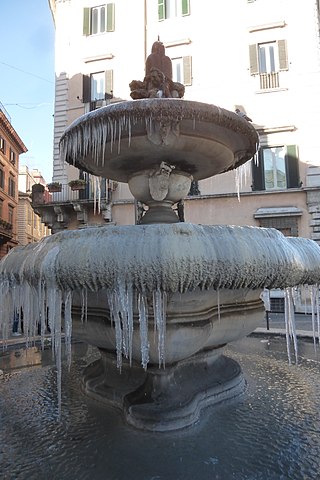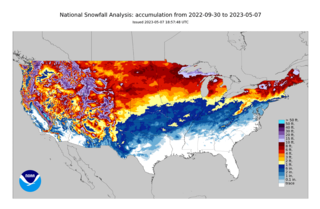
The 1993 Storm of the Century was a cyclonic storm that formed over the Gulf of Mexico on March 12, 1993. The cold weather, heavy snowfall, high winds and storm surges that the storm brought affected a very large area; at its height, it stretched from Canada to Honduras. The cyclone moved through the Gulf of Mexico and then through the eastern United States before moving on to eastern Canada. It eventually dissipated in the North Atlantic Ocean on March 15.

The Great Blizzard of 1899, also known as the Great Arctic Outbreak of 1899 and the St. Valentine's Day Blizzard, was an exceptionally severe winter weather event that affected most of the United States, particularly east of the Rocky Mountains. On February 11, Swift Current in present-day Saskatchewan reported a record-high barometric pressure of 31.42 inches of mercury (1,064 mb).

A cold wave is a weather phenomenon that is distinguished by a cooling of the air. Specifically, as used by the U.S. National Weather Service, a cold wave is a rapid fall in temperature within a 24-hour period requiring substantially increased protection to agriculture, industry, commerce, and social activities. The precise criteria for a cold wave are the rate at which the temperature falls, and the minimum to which it falls. This minimum temperature is dependent on the geographical region and time of year.
The cold wave of 1978 was a weather event that occurred in the Eastern United States. Beginning in December 1977 and lasting until March, it produced one of the coldest winters on record in all states east of the Rocky Mountains, except Maine.

It is very rare for snow to fall in the U.S. state of Florida, especially in the central and southern portions of the state. With the exception of the far northern areas of the state, most of the major cities in Florida have never recorded measurable snowfall, though trace amounts have been recorded, or flurries in the air observed few times each century. According to the National Weather Service, in the Florida Keys and Key West there is no known occurrence of snow flurries since the European colonization of the region more than 300 years ago. In Miami, Fort Lauderdale, and Palm Beach there has been only one known report of snow flurries observed in the air in more than 200 years; this occurred in January 1977. In any event, Miami, Fort Lauderdale, and Palm Beach have not seen snow flurries before or since this 1977 event.

The climate of the north and central parts of the US state of Florida is humid subtropical. South Florida has a tropical climate. There is a defined rainy season from May through October when air mass thundershowers that build in the heat of the day drop heavy but brief summer rainfall.

Much of the state of Florida is situated on a peninsula between the Gulf of Mexico, the Atlantic Ocean, and the Straits of Florida. Spanning two time zones, it extends to the northwest into a panhandle along the northern Gulf of Mexico. It is bordered on the north by the states of Georgia and Alabama, on the west, at the end of the panhandle, by Alabama. It is near The Bahamas, and several Caribbean countries, particularly Cuba. Florida has 131 public airports, and more than 700 private airports, airstrips, heliports, and seaplane bases. Florida is one of the largest states east of the Mississippi River, and only Alaska and Michigan are larger in water area.

The climate of Miami is classified as having a tropical monsoon climate with hot and humid summers; short, warm winters; and a marked drier season in the winter. Its sea-level elevation, coastal location, position just above the Tropic of Cancer, and proximity to the Gulf Stream shape its climate.

The January 1987 snowfall was a very heavy lake-effect type snow event that affected the United Kingdom, mainly the areas of East Anglia, South-East England and London between 11 and 14 January and was the heaviest snowfall to fall in that part of the United Kingdom since the winter of 1981/82. Over 50 centimetres (20 in) of snow fell in South East England, with some locations reporting snowfall at 75 centimetres (30 in). Ireland was also affected by the cold wave, reporting more than 10 centimetres (3.9 in) in some areas.

A deadly cold wave started in Europe on January 27, 2012, and brought snow and freezing temperatures to much of the continent. There were more than 824 reported deaths in both Europe and North Africa. Particularly low temperatures hit several Eastern and Northern European countries, reaching as low as −42.7 °C (−44.9 °F) in Finland. The heaviest snow was recorded in the Balkan region. The cold weather was a result of an extensive area of very high pressure located over the north east of the continent in northern Russia, which circulated cold air from the east.

The 2013 extreme weather events included several all-time temperature records in Northern and Southern Hemisphere. The February extent of snow cover in Eurasia and North America was above average, while the extent of Arctic ice in the same month was 4.5% below the 1981–2010 average. The Northern Hemisphere weather extremes have been linked to the melting of Arctic sea ice, which alters atmospheric circulation in a way that leads to more snow and ice.

The 1994 North American cold wave occurred over the midwestern and eastern regions of the United States and southern Canada in January 1994. The cold wave caused over 100 deaths in the United States. Two notable cold air events took place from January 18–19 and January 21–22. There were 67 minimum temperature records set on January 19. During this time, much of the United States experienced its coldest temperatures since February 1934.

The early 2014 North American cold wave was an extreme weather event that extended through the late winter months of the 2013–2014 winter season, and was also part of an unusually cold winter affecting parts of Canada and parts of the north-central and northeastern United States. The event occurred in early 2014 and was caused by a southward shift of the North Polar Vortex. Record-low temperatures also extended well into March.

The 2013–14 North American winter was one of the most significant for the United States, due in part to the breakdown of the polar vortex in November 2013, which allowed very cold air to travel down into the United States, leading to an extended period of very cold temperatures. The pattern continued mostly uninterrupted throughout the winter and numerous significant winter storms affected the Eastern United States, with the most notable one being a powerful winter storm that dumped ice and snow in the Southeastern United States and the Northeastern United States in mid-February. Most of the cold weather abated by the end of March, though a few winter storms did affect the Western United States towards the end of the winter.

The 2014–15 North American winter was frigid and prolifically wintry, especially across the eastern half of North America in the months of January–March. The season began early, with many places in North America experiencing their first wintry weather during mid-November. A period of below-average temperatures affected much of the contiguous United States, and several records were broken. An early trace of snowfall was recorded in Arkansas. There were greater accumulations of snow across parts of Oklahoma as well. A quasi-permanent phenomenon referred to as the polar vortex may have been partly responsible for the cold weather. Temperatures in much of the United States dropped 15 to 35 °F below average by November 19, following a southward "dip" of the polar vortex into the eastern two-thirds of the country. The effects of this dip were widespread, bringing about temperatures as low as 28 °F (−2 °C) in Pensacola, Florida. Following a significant snowstorm there, Buffalo, New York received several feet of snow from November 17–21. In addition, significant winter weather occurred throughout the season, including a major blizzard that struck the Northeastern United States at the end of January, another blizzard that affected much of the Northern United States days later in early February, and several significant snow events paired with very frigid temperatures for much of February.

A period of exceptionally cold and snowy winter weather in January 2017 occurred in Eastern and Central Europe. In some areas, flights and shipping services were suspended, and there was major disruption to power supplies and other essential infrastructure. The weather was the result of stationary high pressure over western Europe, resulting in strong winds circulating from Russia and Scandinavia towards eastern Europe. On 9 January, the Continental Arctic (cA) air mass extended from Germany across the Balkans, resulting in deep snow in Greece and strong bora winds affecting Croatia in particular. In addition, heavy snow in central and Southern Italy was the result of cold air flowing across the warmer Adriatic Sea. At least 73 deaths were attributed to the cold wave.

The February 2015 North American cold wave was an extreme weather event that affected most of Canada and the eastern half of the United States. Following an earlier cold wave in the winter, the period of below-average temperatures contributed to an already unusually cold winter for the Eastern U.S. Several places broke their records for their coldest February on record, while some areas came very close. The cause of the cold wave was due to the polar vortex advancing southward into the eastern parts of the U.S, and even making it as far south as the Southeast, where large snow falls are rare. By the beginning of March, although the pattern did continue for the first week, it abated and retreated near the official end of the winter.

The 2017–18 North American winter saw weather patterns across North America that were very active, erratic, and protracted, especially near the end of the season, resulting in widespread snow and cold across the continent during the winter. Significant events included rare snowfall in the South, an outbreak of frigid temperatures that affected the United States during the final week of 2017 and early weeks of January, and a series of strong nor'easters that affected the Northeastern United States during the month of March. In addition, flooding also took place during the month of February in the Central United States. Finally the winter came to a conclusion with a powerful storm system that caused a tornado outbreak and blizzard in mid-April. The most intense event, however, was an extremely powerful cyclonic blizzard that impacted the Northeastern United States in the first week of 2018. Similar to the previous winter, a La Niña was expected to influence the winter weather across North America.
The Spring 2013 United Kingdom cold wave was a period of unusually cold weather in the United Kingdom between 6 March and early April 2013. The cold wave consisted of very low temperatures and significant snowfall. Freezing temperatures worsened due to the significant overcast and cloud covered skies. Extensive snowfall occurred on 11 and 12 March in the South East, North and West of England and Wales. Most parts of England, north Wales and the Isle of Man also suffered heavy persistent snowfall on 22 and 23 March 2013.

The 2022–23 North American winter was an unusually warm winter for the east and an unusually cold winter for the west in North America, as it occurred across the continent from late 2022 to early 2023. The winter season in North America began at the winter solstice, which occurred on December 21, 2022, and it ended at the March equinox, which occurred on March 20, 2023. The first day of meteorological winter began on December 1 and unofficially ended on February 28; winter storms may still occur outside of these limits.


















